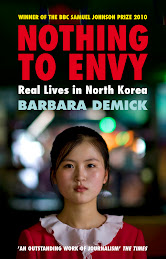Saturday, 28 February 2009
Tuesday, 24 February 2009
Obama, the new US President
Wednesday, 18 February 2009
Slumdog Millionaire

This is really a fanastic show! I enjoyed it so much. 5N, go watch it! The movie will show you how living in the slums is like. Didn't we learnt that in 'Development'? Of course, you're not there to watch the slums. The story line and cinematography are just as wonderful. Thumbs up! Unfortunately Sec 4 cannot watch, it's rated NC-16. Er.. next year?
Tuesday, 17 February 2009
Rare drought ravages China


Eight northern and central wheat-growing provinces are hit
5 Feb 2009, ST
BEIJING - CHINA has declared an emergency over a long dry spell threatening crops and farmers' incomes in the rural heartland, official media said on Thursday.
The drought gripping parts of central and northern China has sent Zhengzhou wheat futures prices up 5 per cent this week but physical prices have not moved, with most investors confident the country's reserves and last year's big harvest can offset any fall in wheat production this spring.
But the dry could hurt the incomes of farmers in Henan, Anhui and other populous provinces when many have lost factory and construction jobs after China's growth faltered in late 2008.
The national Office of State Flood Control and Drought Relief declared a 'level 2' emergency, calling it a 'severe drought rarely seen in history", the People's Daily and other official media reported.
Zhang Zhitong, a deputy chief of the office, said local officials must make 'fighting the drought and protecting seedlings a major task' and expand irrigation coverage.
The absence of rain or snow since November has affected 9.5 million hectares of farmland - 43 per cent of the winter wheat sources, the China Daily reported.
But almost 40 per cent of drought-hit wheat areas in seven provinces had been irrigated, the Agriculture Ministry said on Wednesday, easing worries about lost crops.
The ministry said farmers in these provinces, including Henan, Shandong and Hebei, had irrigated 3.79 million hectares of wheat, accounting for 39.6 per cent of the 9.5 million hectares hit by drought.
Ma Wenfeng told the China Daily the drought could reduce annual production in major wheat-growing areas by 2 to 5 per cent.
'The severest-hit regions of Henan and Anhui will see their wheat harvest down by about 20 per cent,' Mr Ma said.
Both those provinces are home to millions of migrant labourers who travel from villages to cities and coastal industrial zones for work. And this week, the government said that around 20 million of the nation's 130 million migrant workers had lost their jobs because of the economic slowdown. – REUTERS
Sunday, 15 February 2009
S'pore to mark Earth Hour
By Amresh Gunasingham & Liaw Wy-Cin
THE Global Earth Hour is gaining traction here.
Its growing list of supporters this year includes Deputy Prime Minister and Coordinating Minister for National Security S. Jayakumar.
Pledging his support, Professor Jayakumar said: 'Climate change is one of the most serious long-term challenges facing humankind. An enduring global solution must involve the combined effort of governments, businesses, NGOs (non-governmental organisations), and individuals.'
Earth Hour, which started in 2007, is an annual event aimed at getting as many individuals, households and businesses around the world to turn off their lights and electrical appliances for one hour to bring awareness to climate change and conservation.
This year, tertiary institutions and a number of businesses islandwide will shut off exterior lights for an hour from 8.30pm on March 28. Residents are also encouraged to switch off their lights at home.
The target is to get a million people in Singapore to 'switch off'. This is Singapore's first official participation in the event, organised by the World Wide Fund for Nature (WWF).
More than a billion people from 1,000 cities around the world are expected to take part this time round.
A spokesman for WWF said that participating in Earth Hour provides a 'united global message' to individuals, businesses, politicians and governments that climate change affects, and is the responsibility of, the global community.
The inaugural Earth Hour, which took place in Sydney on March 31 two years ago, saw more than two million people and 2,000 businesses across the city taking part.
Last year, it swelled to 50 million people from 35 countries worldwide.
Prof Jayakumar said Earth Hour 2009 would help promote public awareness of the importance of addressing climate change.
Property developer CapitaLand was one of the few Singapore companies to take part last year.
'In 2008, CapitaLand's proactive initiatives to reduce, reuse and recycle enabled us to cut electricity and water consumption and avoid the equivalent of about $2 million in utility costs in Singapore alone,' said its group president and chief executive Liew Mun Leong. This year, CapitaLand is involving more of its properties here and overseas in the event.
SingTel is also getting into the act.
Mr Olivier Carnohan, SingTel's head of eBusiness, said customers will receive an insert in their bills - made of recycled paper - informing them of Earth Hour and encouraging them to participate. An SMS will also be circulated as a reminder.
The National University of Singapore (NUS) plans to hold a candlelight vigil involving up to 2,000 students. Said Mr Loo Deliang from NUS' office of environmental sustainability: 'We hope this spreads awareness of the climate change campaign and promotes the idea that every individual counts.'
amreshg@sph.com.sg
wycin@sph.com.sg
Life in jail for Rwanda's genocide leader



The skulls of victims in the Nyarama Church are chilling reminders of the Rwanda genocide in 1994, when hundreds of thousands were killed. -- PHOTO: AGENCE FRANCE-PRESSE
A genocide survivor grieves over the mummified remains of relatives at a memorial centre in Rwanda. Most survivors of the atrocity have expressed satisfaction after the UN-backed war crimes court sentenced the mastermind to life in prison. -- PHOTO: AGENCE FRANCE-PRESSE
19 Dec 2008, ST
NAIROBI: A United Nations court has sentenced a former army colonel accused of masterminding Rwanda's genocide in 1994 to life in prison.
The International Criminal Tribunal for Rwanda (ICTR), based in Tanzania, has accused Theoneste Bagosora, 67, of being in charge of the troops and the extremist Interahamwe Hutu militia that butchered 800,000 minority Tutsis and moderate Hutus in 100 days.
'Colonel Bagosora is guilty of genocide and crimes against humanity and war crimes,' the court said yesterday.
The slaughter is thought to have been triggered by the mysterious downing of a plane carrying Rwanda's then-president Juvenal Habyarimana, a Hutu, and his Burundian counterpart on April 6, 1994.
The tribunal ruled that Bagosora was also responsible for the assassination of former prime minister Agathe Uwilingiyimana.
It also ruled that Bagosora, then the Cabinet director of the Defence Ministry, was behind the massacre of Tutsis at road blocks in Kigali, the capital, and in his home region of Gisenyi in the north.
After the genocide, he fled into exile in Cameroon, where he was later arrested in 1996. His trial began in 2002 and lasted five years until mid-2007.
Bagosora faced 11 charges of genocide, war crimes and crimes against humanity. He was tried along with three co-defendants, two of whom, also ex-military officers, were also sentenced to life, while the third was acquitted. Bagosora's lawyer said his client would challenge his conviction.
Earlier, the court sentenced businessman Protais Zigiranyirazo, brother-in-law of Habyarimana, to 20 years in prison for genocide and extermination. He has already served seven years.
Zigiranyirazo was convicted of 'aiding and encouraging' the killing of some 1,500 Tutsis on April 8, 1994 in northern Rwanda and 10 to 20 others near Kigali.
REUTERS, AGENCE FRANCE-PRESSE
I'm sure those who came and stayed on the show enjoyed the movie. Do share your feelings under comments how you feel after watching 'Hotel Rwanda'.
Monday, 9 February 2009
Movie Screening @ CCSS
 Date: 13 February 2009
Date: 13 February 2009Time: 1.30pm
Venue: AVA Room
This movie screening is for 4EA and 4EB. 5N1 and 5N2 are welcomed too. This is one of my all time favourite movies. Gripping and emotional. It really sums up a lot of the concepts we learn in SS. For example the causes of conflict in a multi-ethnic society and the effectivenss of the international organisation such as UN. This movie is also about heroes and I like movies with heroes. :-)
Some guiding questions for you before we watch the movie:
1. What is a genocide?
2. Who is the hero in the movie and why is he a hero?
3. Who are the two groups of people involved in the conflict?
4. How did the conflict develop?
Please visit the official website to understand more about the movie. Answers for the questions above can be found at the website. We've a movie date on Friday, see you!
Sunday, 1 February 2009
Slow Down, Brave Multitasker, and Don’t Read This in Traffic
Super Rice

 Experts at the International Rice Research Institute are trying to boost crop yield through genetic engineering, so that Asia can grow more rice on less land. -- ST PHOTO: ALASTAIR MCINDOE
Experts at the International Rice Research Institute are trying to boost crop yield through genetic engineering, so that Asia can grow more rice on less land. -- ST PHOTO: ALASTAIR MCINDOE1 Feb, ST
Experts to tweak plant genes to boost yield by half and cut water and fertiliser needs
By Alastair McIndoe, Philippines Correspondent
Manila - Crop scientists call it supercharging the rice engine.
The International Rice Research Institute (IRRI) in the Philippines is launching a far-reaching project to boost rice yields by 50 per cent or more through genetic engineering to meet future demand for the staple food from rising populations.
It centres on re-engineering rice's photosynthesis - the means by which plants derive energy to grow - which the IRRI's scientists say has the potential to usher in nothing short of a new Green Revolution in Asia, the world's rice bowl.
A US$11 million (S$17 million) funding from the Bill and Melinda Gates Foundation has got the project rolling.
IRRI has formed a network of the world's experts on photosynthesis, including scientists from the universities of Oxford and Yale, for the task ahead. They are set to meet in April at IRRI's headquarters in Los Banos to draw up a research-and-development roadmap.
Last year's rocketing rice prices put the spotlight on whether Asia would be able to grow enough rice in the future because there are limitations to increasing production using current technologies.
Land for growing rice is getting scarcer across the region from creeping urbanisation and other uses. Simply put, Asia needs much more rice from less land.
The IRRI estimates that by 2050, rice production must rise by 50 per cent in Asia going by the region's current trend of population growth and rice output.
'We have a huge problem and superior photosynthesis is perhaps the only mechanism that can solve it,' said Dr John Sheehy, who heads the project at the IRRI.
Unlike rice, crops such as maize and sorghum have more effective systems of photosynthesis, enabling them to produce higher yields. These are called C4 plants, since they initially form a molecule with four carbon atoms during photosynthesis. Rice is classified as a C3 plant, with a less effective photosynthesis mechanism.
Scientists on the project aim to identify the C4 gene in maize and sorghum, and then construct genetic material from those plants that can be used to modify rice.
It will likely take at least a decade to produce a prototype rice plant, and another five years before C4 rice seeds reach farmers. On paper at least, C4 rice would not only significantly boost yields, but also need less water and nitrogen fertiliser.
'Considering that more than 90per cent of the world's rice is consumed within Asia and is the major staple for hundreds of millions of poor - and often undernourished - people, improving the efficiency of photosynthesis in rice would have an enormous impact,' said the IRRI's spokesman Duncan Macintosh.
What is more, added Dr Sheehy, 'the genes that we discover and construct for C4 rice can be put in other crops, such as wheat in Africa in dryland areas, helping to increase their production as well'.
The debate over genetically modified (GM) crops is as heated as ever, especially in Europe. Among the concerns is the ethical opposition to 'playing with nature'.
But the technology has been used to help crops better adapt to pests, disease and harsh environments. The biotech lobby also believes GM crops, such as pro-Vitamin A 'golden rice' that is being developed by the IRRI and others, can play a vital role in combating world hunger.
'I understand the concerns about some GM techniques, such as injecting an alien protein into rice; that would require caution,' said Dr Sheehy. 'But with the photosynthesis mechanism we don't need to do that. All we are doing is working to produce more carbohydrate and energy.
'C4 rice would be no more dangerous than mixing Rice Krispies and cornflakes in the same bowl.'
About 100 scientists from IRRI and universities and research institutions in Australia, Britain, Canada, Germany and the United States will work on the project.
The cost of producing a commercial variety of C4 rice is estimated at US$120 million.
'We're hoping for some early successes to encourage the Gates Foundation and national science councils in Asia to commit to larger amounts,' said Dr Sheehy.
IMPROVING PHOTOSYNTHESIS
# C3 plants such as rice photosynthesise less effectively than C4 plants such as maize.
# Planting C4 gene into rice will make it photosynthesise more effectively.
# C4 rice will need less water and less nitrogen fertiliser than C3 rice.
# C4 rice plants will boost yields by more than 50 per cent.
amcindoe@yahoo.com


















